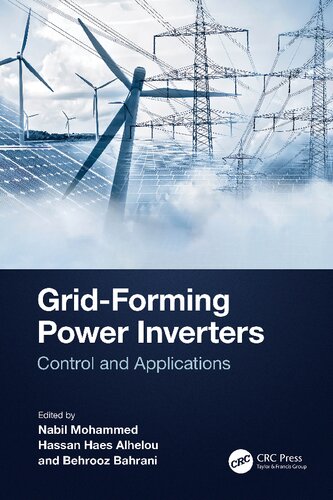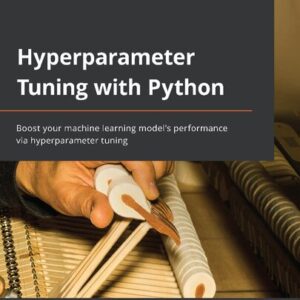Grid-Forming Power Inverters: Control and Applications is the first book dedicated to addressing the operation principles, grid codes, modelling and control of grid-forming power inverters. The book initially discusses the need for this technology due to the substantial annual integration of inverter-based renewable energy resources. The key differences between the traditional grid-following and the emerging grid-forming inverters technologies are explained. Then, the book explores in detail various topics related to grid-forming power inverters, including requirements and grid standards, modelling, control, damping power system oscillations, dynamic stability under large fault events, virtual oscillator-controlled grid-forming inverters, grid-forming inverters interfacing battery energy storage, and islanded operation of grid-forming inverters. Features: Explains the key differences between grid-following and grid-forming inverters Explores the requirements and grid standards for grid-forming inverters Provides detailed modeming of virtual synchronous generators Explains various control strategies for grid-forming inverters Investigates damping of power system oscillations using grid-forming converters Elaborates on the dynamic stability of grid-forming inverters under large fault events Focuses on practical applications Table of contents : Cover Half Title Title Page Copyright Page Table of Contents Preface Editors Contributors Introduction Chapter 1 Introduction to Grid-Forming Inverters 1.1 Overview 1.2 Virtual Synchronous Generator 1.3 GFL and GFM Inverters 1.4 Comparison Between GFLIs and GFMIs 1.5 Framework Modeling 1.6 Methods of GFMI Control 1.7 Challenges of Grid-Forming Inverters 1.8 Discussion 1.9 Conclusion References Chapter 2 Requirements and Grid Standards for Grid-Forming Inverters 2.1 Introduction 2.2 System Scarcities and Stability Issues with High Share of IBRs 2.3 Comparison of GFMI, Grid-Following Inverter, and Synchronous Sources: System Services Perspective 2.4 Overview of System Services From GFMIs and Performance Requirements 2.5 Challenges Associated with Large-Scale Integration of GFMI 2.6 Pathways for Wide-Scale Adoption of GFMI in Power System 2.7 State of Play and Advancements in GFMI Grid Codes 2.8 Conclusions References Chapter 3 Power System Requirements for Grid-Forming Converters 3.1 Introduction: Background and Driving Forces 3.2 Frequency Response and Control 3.2.1 Inertia 3.2.2 Primary Frequency and Droop Control 3.2.3 Fast Frequency Response 3.2.4 Needs for Energy Reserve/Storage to Enable Grid-Forming Capability 3.3 Active Power Requirements 3.4 Fast Fault Current Injection and Short Circuit Contribution 3.5 Fault Ride-Through 3.5.1 Voltage Ride-Through 3.5.2 Frequency Ride-Through 3.6 Reactive Power Requirements and Voltage Regulation 3.7 Black Start and Island Operation References Chapter 4 Toward Performance-Based Requirements and Generic Models for Grid-Forming Inverters 4.1 Introduction 4.2 Operational Similarity Across Different Grid-Forming Control Types 4.2.1 Type B Droop-Based Grid-Forming Control 4.2.2 Grid-Forming Control Comparison 4.3 Toward Performance-Based Interconnection Requirements for Grid-Forming Inverters 4.4 Generic Model Development for Large System Studies 4.5 Conclusion References Chapter 5 An Overview of Modeling and Control of Grid-Forming Inverters 5.1 Introduction 5.2 Basic Definition of Grid-Forming Converters 5.3 Modeling of Grid-Forming Converters 5.4 Control of Grid-Forming Converters 5.4.1 General Control Structure of Grid-Forming Converters 5.4.2 Outer Loop: Power Synchronization Loop 5.4.3 Outer Loop: Voltage Profile Management 5.4.4 Inner Loop: Calculation of Modulation Signals 5.4.4.1 Cascade Control by Using Sliding Mode Controller for Current Controller 5.4.4.2 Direct Voltage Control by Using Sliding Mode Controller 5.4.4.3 Direct Voltage Control by Using Fractional-Order Sliding Mode Controller 5.5 Summary References Chapter 6 Small-Signal Modeling and Validation Including State-Space and Admittance Models of the Virtual Synchronous Machine 6.1 Introduction 6.2 Introduction of the Studied System and Modeling Method 6.2.1 System Description 6.3 CCM Description 6.4 Small-Signal Modeling of VSM 6.4.1 LCL Filter Model 6.4.1.1 Basic Electrical Model 6.4.1.2 Resonance Frequency Damping 6.4.2 Combined dq ? Frame Voltage, Current PI Control, and PWM Delay 6.4.2.1 Current Control Loop 6.4.2.2 Voltage Control Loop 6.4.2.3 Pad? Approximation 6.4.2.4 Combined Voltage and Current Control Loop 6.4.3 Shaft Swinging Emulation 6.4.3.1 Swing Equation 6.4.3.2 Power Regulation 6.4.3.3 Low-Pass Filter (LPF) 6.4.3.4 Swing Equation with Power Filter 6.5 Reactive Power Control 6.5.1 Implementation Using the LPF and Droop Control 6.6 Frame Rotation 6.7 Derivation and Validation of the Whole-System Small-Signal Model 6.7.1 Derivation and Validation of the State-Space Model 6.7.1.1 Time Domain Validation 6.8 Derivation and Validation of the Admittance Model 6.9 Conclusion References Chapter 7 Grid-Forming Control of Doubly Fed Induction Generators 7.1 Introduction 7.2 System Description 7.3 DFIG Dynamic Model 7.4 DFIG Equivalent Circuit 7.5 DFIG Electromagnetic Torque and Reactive Power 7.6 DFIG Torque Synchronization Loop 7.7 DFIG Rotor Flux Control 7.8 Simulation Results 7.8.1 DFIG Response to a Step in Wind Velocity at Partial Load 7.8.2 DFIG Response to a Step Command in Reactive Power 7.8.3 DFIG Response to a System Load Step 7.8.4 Wind Farm (WF) Response to a Load Step 7.8.5 DFIG Response to the Transition from Grid Connected to Isolated 7.9 Conclusions Appendix References Chapter 8 Damping Power System Oscillations Using Grid-Forming Converters 8.1 Introduction 8.2 System Description and Modeling 8.3 Grid-Forming Converter Stabilizer 8.4 STATCOM Stabilizer 8.5 Stability Analysis 8.5.1 Small-Signal Stability 8.5.2 Time-Domain Response 8.6 Two-Area System 8.6.1 Eigenvalues Loci Under Variation of Parameters 8.6.2 Dynamic Response to a Load Change 8.6.3 Dynamic Response to a Line Tripping 8.7 Conclusions Appendix A. System Parameters and Operation Points Appendix B. Linearized Models Appendix C. Models Parameters References Chapter 9 Grid-Forming Dynamic Stability Under Large Fault Events ? Application to 100% Inverter-Based Irish Power System 9.1 Grid-Forming Requirements for Future Grids with High Shares of Renewables 9.2 GFMI Modelling, Current Limiting, and Control Design 9.2.1 Droop Control with Inner Cascaded Voltage and Current PI Control Loops 9.2.2 Virtual Synchronous Machine Control 9.2.3 Dispatchable Virtual Oscillator Control-Based Grid-Forming Inverter Modelling 9.2.4 Grid-Forming Inverter Angular Speed Freezing 9.3 Irish Grid Case Study With 100% GFMIs 9.3.1 Urban and Remote Grid Models 9.3.2 Urban Irish Grid with 100% GFMIs (Droop, dVOC Control) 9.3.3 Remote Irish Grid with 100% GFMIs (Current Limiting Strategies and Virtual Angular Speed Freezing) 9.3.3.1 Current Saturation and Virtual Impedance Limiting Control 9.3.3.2 GFMI Transient Stability Enhanced by Virtual Angular Speed Freezing 9.4 Conclusions References Chapter 10 Virtual Oscillator-Controlled Grid-Forming Inverters Incorporating Online Parametric Grid Impedance Identification 10.1 Overview 10.2 Introduction 10.3 Conventional VOC 10.4 Proposed Implementation of Online Grid Impedance Estimation for dVOC 10.5 Non-Parametric Grid Impedance Estimation Based on PRBS Injection 10.5.1 Disturbance Injection 10.5.2 Non-Parametric GIE 10.6 Parametric Impedance Based on Complex Curve Fitting 10.7 Simulation Results 10.7.1 Active and Reactive Power Dispatch 10.7.2 Online GIE 10.7.3 Effects of Notch Filter on THD% 10.8 HIL Experimental Results 10.8.1 Active and Reactive Power Dispatch 10.8.2 Online GIE 10.9 Chapter Summary References Chapter 11 Grid-Forming Inverters Interfacing Battery Energy Storage Systems 11.1 Introduction 11.2 Inverter Architecture 11.3 Control Architecture for GFM Inverter 11.3.1 GFL Control 11.3.2 GFM Control 11.4 BESS Model 11.4.1 BESS Components 11.4.2 Battery Chemistry Types 11.5 Integrated BESS with GFM Inverter Model 11.5.1 Integrated Model: BESS 11.5.2 Integrated Model: DC/AC Filter 11.5.3 Integrated Model: DC-AC Converter 11.5.4 Integrated Model: Solar (PV) Panel 11.6 Grid-Connected/Islanded Large-Scale Battery Energy Storage Systems 11.7 Application: How to Develop the Model in a Software Platform (e.g., MATLAB/Simulink) 11.7.1 Detailed GFL Architecture 11.7.2 Detailed GFM Architecture 11.8 Simulation Results 11.8.1 Test System 1: BESS with a Single Machine 11.8.2 Cases on Test System 1 11.8.2.1 Case 1: GFL and GFM 11.8.2.2 Case 2: Step Change in Load in GFM with PV Supply 11.8.2.3 Case 3: Fault at PCC in GFM with PV Supply 11.8.3 Test System 2: BESS and PV Integrated with IEEE 13 Bus 11.8.4 Cases on Test System 2 11.8.4.1 Case 1: GFL and GFM 11.8.4.2 Case 2: Step Change in Load in GFM with PV Supply 11.8.4.3 Case 3: Fault at PCC in GFM with PV Supply 11.9 Chapter Summary and Conclusion References Chapter 12 Operation of Grid-Forming Inverters in Islanded Mode 12.1 Introduction 12.2 Control Models of the Studied MG Components 12.2.1 Modelling of WTs with Control Structure 12.2.2 Modelling a PV System with a Control Structure 12.2.3 Using Control Structure in ESS Modelling 12.2.4 Using a Control Structure for IPC Modelling 12.3 IPC Control Method Based on FCS-MPC 12.3.1 IPC Control Methods Based on the Studied MG’s Operation Modes 12.4 For the Researched MG, an Integrated EMS with Coordinated Control 12.4.1 Mode 1 Operation (Standalone) 12.5 Results and Discussion of the Simulation 12.5.1 Step Change in AC Load with Higher SOC in Islanded Mode 12.5.2 Step Change in AC Load with Lower SOC in Islanded Mode 12.5.3 Regulation of DC Voltage in Rectification Mode with Constant DC Load 12.5.4 Under DC Voltage Variation, DC Voltage Regulation During Rectification 12.5.5 Under Low DC Load Variation, Rectification Mode DC Voltage Regulation 12.5.6 Under High DC Load Variation, Rectification Mode AC Voltage Regulation 12.5.7 Regulating the AC Voltage While Using an Islanded Inverter with a Constant AC Load 12.5.8 Regulation of AC Voltage in Islanded Inverter Mode with Variable AC Load 12.5.9 Under a Non-Linear AC Load, an Islanded Inverter Is Used 12.5.10 Comparison of Load Ripples and THD 12.6 Conclusion Nomenclature References Index
digsell.net collection
[PDF] Grid-Forming Power Inverters: Control and Applications Hassan Haes Alhelou, Nabil Mohammed, Behrooz Bahrani
$9.99






Reviews
There are no reviews yet.